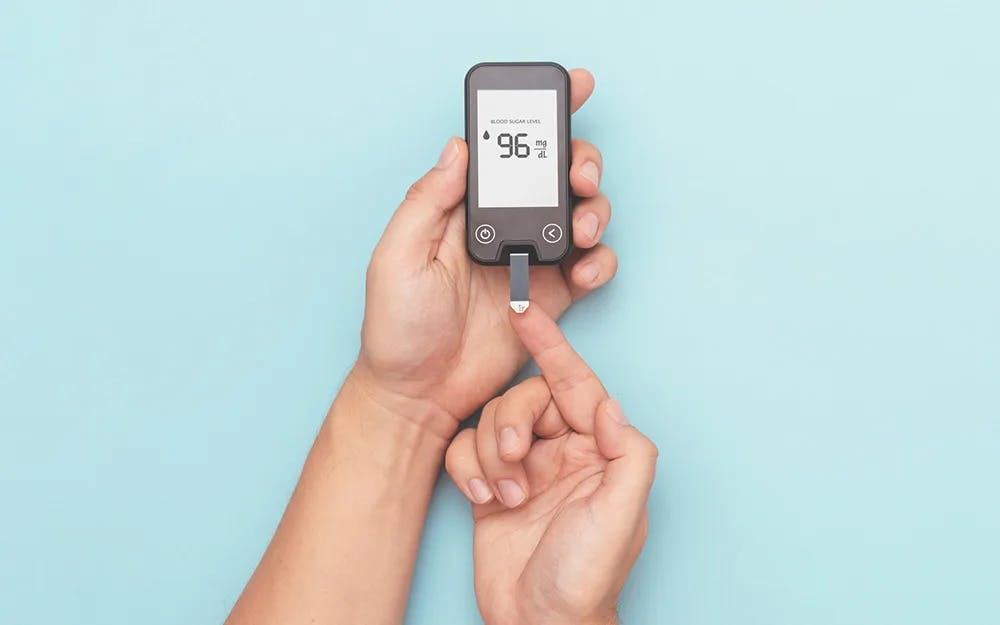
Health Spotlight: Diabetes
In 2020, around 1 in 20 Australians were living with diabetes1
Diabetes was the underlying cause of around 5,100 deaths and contributed to around 17,500 deaths in 20202
Almost 1.3 million hospitalisations were associated with diabetes in 20202
Diabetes and heart disease were the two most common comorbidities associated with COVID-19 hospitalisations in 2020-212
What is diabetes?
Diabetes is a chronic condition where the glucose (sugar) in your blood is too high.
It means your body is not effectively producing insulin, a hormone made by the pancreas which helps to convert glucose from food into energy. Over time, high glucose levels in your blood can cause other health problems, such as heart, kidney, eye and foot damage.3
There are three main types of diabetes – type 1 diabetes, type 2 diabetes and gestational diabetes.
Type 1 diabetes is an autoimmune disease usually diagnosed in childhood, where the body attacks cells that produce insulin. Type 2 diabetes usually develops later in life and occurs when the body gradually loses the ability to produce enough insulin. Gestational diabetes occurs during pregnancy and usually disappears after the birth of a baby.
Type 2 diabetes is the most common type of diabetes, representing 85-90 per cent of all cases.4
Warning signs
Higher than usual glucose levels in your blood can make you feel tired and can present symptoms such as frequent urination and dehydration as your kidneys work harder than normal to pass the excess glucose out of your body.
Other common symptoms include always feeling hungry, having cuts that heal slowly and skin infections. However, many people with type 2 diabetes may have no symptoms at all. Type 1 diabetes is usually spotted quickly because symptoms come on quickly.5
Diabetes can be diagnosed through a number of different blood tests, including a simple blood glucose test, oral glucose tolerance test, or an HbA1c test which measures how much glucose has been in your blood over the past few months.5
Risk factors
There are no known causes of type 1 diabetes, but type 2 diabetes can often be brought on by lifestyle factors such as your diet, weight and the amount of physical activity you do. Gestational diabetes is caused by hormone changes in your body during pregnancy, so you are more at risk if you have had it before in previous pregnancies, as well as if you are older and have gained a lot of weight while pregnant.
Age and gender are also a factor in your risk of developing diabetes. In 2020, the prevalence of diabetes in those aged 80-85 was 1 in 5, compared to 1 in 20 for the general population. Diabetes is also more common in men with around 4.8% of Australian men suffering from diabetes compared to 3.8% of women.2
Aboriginal and Torres Strait Islanders are also three times more likely to develop type 2 diabetes than non-Indigenous Australians.6 In addition, if you have a previous family history of diabetes you are more at risk.
How to protect yourself
- Maintain a healthy diet that is low in salt, sugar and processed foods
- Make sure you are getting the recommended amount of physical activity each week – for adults, this is a minimum of 2.5 hours of moderate intensity exercise and 1.25 hours of high intensity exercise7
- Maintain a healthy weight – excess weight around the waistline in particular can increase your risk of type 2 diabetes8
- Talk to your doctor about your risk factors for developing diabetes
- You may want to consider reviewing your insurance needs to ensure your loved ones are protected
1 Includes type 1 and 2 diabetes and other diabetes, excludes gestational diabetes. From ‘Diabetes: Australian facts’, Australian Institute of Health and Welfare, February 2023
2 ‘Diabetes: Australian facts’, Australian Institute of Health and Welfare, February 2023
3 What is diabetes. Diabetes Australia 2023
4 Type 2 diabetes. Diabetes Australia 2023
5 Diabetes. Healthdirect.gov.au, March 2023
6 Diabetes in Australia. Diabetes Australia 2023
7 Physical activity guidelines for adults 18-64. Australian Government Department of Health and Aged Care, May 2021
8 Type 2 diabetes risk factors. Diabetes Australia 2023
You might also be interested in


25 Sept, 2023
Health Spotlight: Prostate cancer
Our latest Health Spotlight article looks at how you can manage your risk of prostate cancer, which will affect around one in six men by the age of 85.Read more
